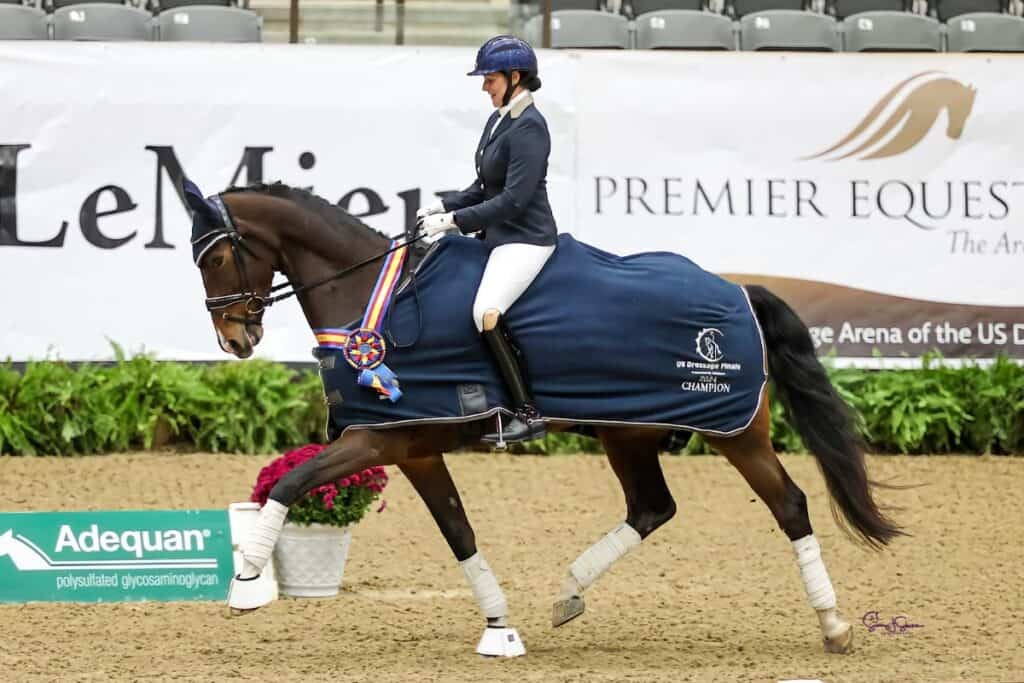If your horse quickly overheats when ridden, doesn’t sweat under his saddle pad or is lethargic during the summer months, he may be suffering from anhidrosis–the reduced ability to sweat. While there is no cure, your veterinarian can develop a management strategy to make your horse more comfortable.
Symptoms
One of the ways horses, like humans, maintain a consistent body temperature is via evaporation through their lungs and skin, i.e. sweating. When a horse cannot sweat, his temperature doesn’t return to normal (99.3-101℉) after exercise and his respiratory rate remains high as his body attempts to evaporate more heat through the lungs.
Symptoms of anhidrosis include dry saddle pads after work, reduced or no sweat, and general lethargy. Horses with chronic anhidrosis often suffer from dry, itchy skin, patchy balding, a listless coat and scaling.
A hot, humid environment makes these symptoms more dramatic because when the ambient temperature and your horse’s skin temperature are equal, evaporation is reduced.
Diagnosis
If you suspect your horse has anhidrosis, contact your veterinarian for diagnosis. Anhidrosis is a serious disorder and can lead to heat cramps, heat exhaustion and heat stroke. Unfortunately, the exact cause of anhidrosis is not known, it may involve overstimulation of the horse's sweat glands by stress hormones. While it is more common in certain breeds and in horses with dark coats, including Friesians, horses from a range of genetics suffer from anhidrosis.
In addition to considering clinical symptoms, your veterinarian can perform a series of injections with dilutions of terbutaline to stimulate the sweat glands. The results identify whether your horse has a problem sweating, as well as the severity of the disorder. Bloodwork that includes an electrolyte analysis is also useful in developing a treatment plan. In rare cases, a skin biopsy may be performed.
Management Strategies
In the most severe cases, a horse may need to be moved to a cooler, dryer climate. Fortunately, for many horses, diligent management strategies ensure they can continue to work happily. Your veterinarian will create a treatment plan specific to your horse, so be sure to follow his/her advice.
Below are common approaches:
● Continual access to cool, fresh water, along with a mineral/salt block.
● Keep the air moving in stalls and outdoor shelters with air conditioning, fans and water misters.
● Nighttime turnout to avoid direct sun and to take advantage of cooler temperatures.
● Supplementation with electrolytes.
● Early morning or late evening exercise.
● Dampen the coat with water before exercise.
● Allow for plenty of cooldown time after exercise. Be sure to monitor respiration rate. Cold hosing will also help bring down the body temperature. Watch carefully for any sign of heat distress.
● Regular grooming to stimulate blood flow to the skin.
● Keep the coat clipped throughout the hot season.
Supplementation at Iron Spring Farm
Michelle Novak, training horse manager at Iron Spring Farm, explains our electrolyte supplementation strategy developed with the farm’s veterinarian. “Because it is hot and humid in Pennsylvania and Florida, especially during the summer months, our horses in full work receive Summer GamesⓇ electrolytes. This helps maintain a healthy electrolyte balance in our horses. We start feeding the electrolytes several weeks prior to the beginning of warm weather, so we don’t have to play catchup with electrolyte levels.”
“We monitor our horses very closely for changes in their sweating patterns, recovery times after work and their internal temperatures. If we see a decrease in sweating and the other management strategies (see above) are no longer effective, we add Equiwinner™ patches, a safe, effective and easy to use ten-day non-transdermal electrolyte-balancing treatment patch. The Friesians historically have a harder time dealing with the heat than our warmbloods and they’ve had a very good response to the Equiwinner™ patches.”
While anhidrosis can be a debilitating disorder, careful monitoring of your horse’s health can lead to early detection and treatment. Contact your veterinarian for more information.
Disclaimer:
All content provided by Iron Spring Farm is general and for informational purposes only. Content may also not constitute the most up to date information. Nothing in this content is intended to constitute veterinarian advice or to serve as a substitute for consultation with a veterinarian. Always seek the advice of your veterinarian or other qualified provider with any questions that you may have about the treatment and care of your horse.
Any reliance that you place on the information provided is strictly at your own risk and Iron Spring Farm, its officers, employees, representatives, and agents, hereby disclaim any and all liability to any party for any direct, indirect, implied, punitive, special, incidental, consequential or other damages arising directly or indirectly from access to or use of any content provided to the maximum extent permitted by law.










